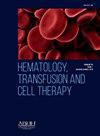同种异体干细胞移植治疗急性髓系白血病的结果:单中心研究
IF 1.6
Q3 HEMATOLOGY
引用次数: 0
摘要
目的本研究的目的是评估我们移植中心诊断为急性髓系白血病(AML)患者的同种异体造血干细胞移植数据。材料与方法2016年至2024年,对176例因诊断为AML而在私立Emsey医院成体干细胞移植单元接受同种异体造血干细胞移植的患者进行回顾性评估。结果对接受异基因移植的AML患者进行回顾性分析,平均年龄为43.2岁。共有130名患者接受了亲属供体移植,46名患者接受了非亲属供体移植。土耳其国家骨髓捐赠银行(TÜRKÖK)是无血缘关系捐赠者的唯一来源。29例供体存在HLA等位基因失配(1个等位基因),80例移植在不同性别间进行。中性粒细胞移植平均时间为17.7 d,血小板移植平均时间为19.5 d。100天死亡率确定为20%。结论aml是一种可以通过异体干细胞移植治疗的血液系统恶性肿瘤。非亲属供体移植对于没有合适的家庭供体而需要同种异体移植的患者是一个关键的选择。我们中心的AML移植患者人口统计数据与文献中的发现一致。急性髓系白血病(AML)是成人中最常见的克隆性造血干细胞疾病。预后是根据年龄、性别、运动状态和细胞基因突变来评估的。造血干细胞移植(HSCT)是一种广泛使用的治疗方法,特别是对血液系统恶性肿瘤。同种异体造血干细胞移植为许多血液系统恶性肿瘤提供了治疗潜力。AML患者进行移植是为了降低复发的风险。完全匹配hla的相关供体是同种异体造血干细胞移植的首选。然而,只有大约25%的患者有完全匹配hla的亲属供体。在这种情况下,可以从不相关的hla匹配供体进行同种异体移植。本研究介绍了在我们的移植中心为AML患者进行的同种异体造血干细胞移植手术的数据。方法回顾性分析2016年至2024年在私立埃姆西医院成体干细胞移植科治疗AML患者的异基因造血干细胞移植病例。结果回顾性分析了176例接受同种异体移植的AML患者。患者中位年龄为43.2岁(范围:16-72岁),其中53% (n = 94)为男性,47% (n = 82)为女性。2例患者(1%)既往接受过自体干细胞移植,7例患者(4%)既往有同种异体移植史。其中,130例(74%)患者接受了hla匹配的同胞供体(MSD)移植,46例(26%)患者接受了非亲属供体移植。所有无血缘关系的捐赠者均来自土耳其国家骨髓捐赠银行(TÜRKÖK)。在176例干细胞供者中,29例(16%)HLA单等位基因不匹配(9/10),147例(86%)HLA完全匹配(6/6和10/10)。共有80例移植(37%)在不同性别之间进行。献血者的中位年龄为39.5岁(范围14-82岁)。作为调节方案,107例患者(61%)接受了清髓调节,57例患者(32%)接受了非清髓调节,12例患者(7%)接受了降低强度调节(RIC)方案。所有患者均使用外周血干细胞,平均输注6.59个 × 10⁶/kg(范围:2.86-15.5个 × 10⁶/kg)干细胞。18例(10%)患者经历了移植物失败,而其余158例患者实现了移植,中性粒细胞移植的中位时间为17.7天(范围:10-32),血小板移植的中位时间为19.5天(范围:10-34)。在158例移植成功的患者中,有18例无法进行嵌合分析。在其余140例患者中,嵌合水平从10%到100%不等,平均为94%。46例(33%)患者出现供体完全嵌合(100%)。在前100天内,35名患者(20%)死亡。在移植成功的患者中,17例(11%)死亡。中位死亡时间为48.2天(范围:8-94天)。结论:尽管强化化疗,仍有10%-40%的AML患者未能达到缓解。即使在达到缓解期的年轻成年患者中,也有大约50%的病例复发。在这一高危人群中,同种异体造血干细胞移植是一种治愈性的治疗选择。非亲属供体移植对于缺乏合适的亲属供体而需要同种异体造血干细胞移植的患者尤其有价值。本中心的AML同种异体造血干细胞移植患者和供体特征、调节方案、移植时间和100天死亡率与文献研究结果一致。本文章由计算机程序翻译,如有差异,请以英文原文为准。
OUTCOMES OF ALLOGENEIC STEM CELL TRANSPLANTATION IN PATIENTS WITH ACUTE MYELOID LEUKEMIA: A SINGLE-CENTER EXPERIENCE
Objective
The aim of this study is to evaluate the allogeneic hematopoietic stem cell transplantation data performed in our transplant center for patients diagnosed with Acute Myeloid Leukemia (AML).
Materials and methods
Between 2016 and 2024, a retrospective evaluation was conducted on 176 patients who underwent allogeneic hematopoietic stem cell transplantation at the Adult Stem Cell Transplant Unit of Private Emsey Hospital due to AML diagnosis.
Results
The retrospective analysis of AML patients who underwent allogeneic transplantation revealed an average age of 43.2 years. A total of 130 patients received a related donor transplant, while 46 underwent unrelated donor transplantation. The Turkish National Bone Marrow Donor Bank (TÜRKÖK) was the only source for unrelated donors. HLA allele mismatch (1 allele) was present in 29 donors, and 80 transplants were performed between different genders. The average time for neutrophil engraftment was 17.7 days, and for platelet engraftment, it was 19.5 days. The 100-day mortality rate was determined to be 20%.
Conclusion
AML is a hematologic malignancy that can be treated with allogeneic stem cell transplantation. Unrelated donor transplantation is a critical option for patients without a suitable family donor who require allogeneic transplantation. Our center’s AML transplant patient demographic data aligns with the findings in the literature.
Case report
Acute Myeloid Leukemia (AML) is the most common clonal hematopoietic stem cell disorder in adults. Prognosis is assessed based on age, gender, performance status, and cytogenetic mutations. Hematopoietic Stem Cell Transplantation (HSCT) is a widely used treatment method, particularly for hematological malignancies. Allogeneic HSCT offers curative potential for many hematologic malignancies. Transplantation is performed in AML patients to reduce the risk of relapse. A fully HLA-matched related donor is the preferred choice for allogeneic HSCT. However, only about 25% of patients have a fully HLA-matched related donor. In such cases, an allogeneic transplant from an unrelated HLA-matched donor may be performed. This study presents data on allogeneic HSCT procedures performed in our transplant center for AML patients.
Methodology
A retrospective analysis was conducted on allogeneic hematopoietic stem cell transplantations performed between 2016 and 2024 in the Adult Stem Cell Transplant Unit of Private Emsey Hospital for AML patients.
Results
A total of 176 AML patients who underwent allogeneic transplantation were retrospectively analyzed. The median patient age was 43.2 years (range: 16–72), with 53% (n = 94) being male and 47% (n = 82) female. Two patients (1%) had previously undergone autologous stem cell transplantation, and seven patients (4%) had a history of prior allogeneic transplantation. Among the patients, 130 (74%) underwent HLA-Matched Sibling Donor (MSD) transplantation, while 46 (26%) received an unrelated donor transplant. All unrelated donors were obtained from the Turkish National Bone Marrow Donor Bank (TÜRKÖK). Among the 176 stem cell donors, 29 (16%) had a one-allele HLA mismatch (9/10), while 147 (86%) were fully HLA-matched (6/6 and 10/10). A total of 80 transplants (37%) were performed between different genders. The median age of donors was 39.5 years (range: 14–82). As a conditioning regimen, 107 patients (61%) received myeloablative conditioning, 57 patients (32%) received a non-myeloablative regimen, and 12 patients (7%) received a Reduced-Intensity Conditioning (RIC) regimen. Peripheral blood stem cells were used for all patients, with an average of 6.59 × 10⁶/kg (range: 2.86–15.5 × 10⁶/kg) stem cells infused. Eighteen patients (10%) experienced graft failure, while the remaining 158 patients achieved engraftment, with neutrophil engraftment occurring at a median of 17.7 days (range: 10–32) and platelet engraftment at a median of 19.5 days (range: 10–34). Among the 158 patients who achieved engraftment, chimerism analysis could not be performed in 18 cases. In the remaining 140 patients, chimerism levels ranged from 10% to 100%, with an average of 94%. Full donor chimerism (100%) was observed in 46 patients (33%). Within the first 100 days, 35 patients (20%) died. Among patients who achieved engraftment, 17 (11%) died. The median time to death was 48.2 days (range: 8–94).
Conclusion
Despite intensive chemotherapy, 10%–40% of AML patients fail to achieve remission. Even among young adult patients who reach remission, relapse occurs in approximately 50% of cases. In this high-risk group, allogeneic HSCT represents a curative treatment option. Unrelated donor transplantation is particularly valuable for patients requiring allogeneic HSCT who lack a suitable related donor. Our center’s AML allogeneic HSCT patient and donor characteristics, conditioning regimens, engraftment times, and 100-day mortality rates are consistent with findings in the literature.
求助全文
通过发布文献求助,成功后即可免费获取论文全文。
去求助
来源期刊

Hematology, Transfusion and Cell Therapy
Multiple-
CiteScore
2.40
自引率
4.80%
发文量
1419
审稿时长
30 weeks
 求助内容:
求助内容: 应助结果提醒方式:
应助结果提醒方式:


